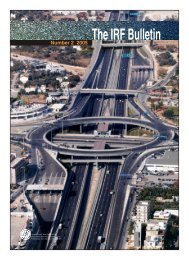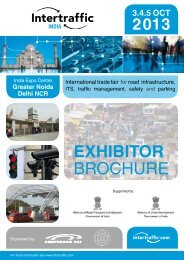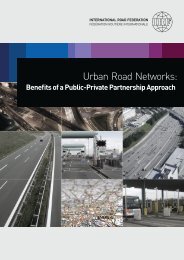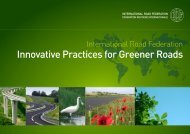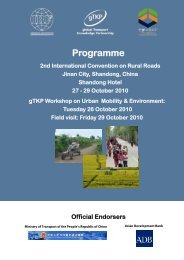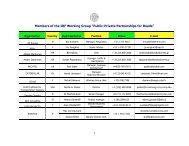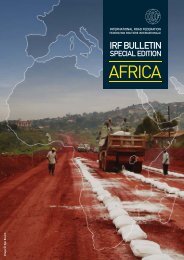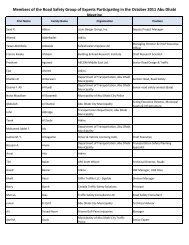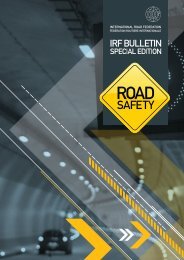TRANSPORT
TRANSPORT
TRANSPORT
- No tags were found...
Create successful ePaper yourself
Turn your PDF publications into a flip-book with our unique Google optimized e-Paper software.
MANAGEMENT<br />
While many exceptions to the general rules shown in figure<br />
3 are, of course, possible, the table may, nevertheless, be<br />
useful – for example, whenever the frequent question<br />
of asphalting rural roads arises. In this context, the table<br />
indicates that the asphalting of rural roads in LLDC countries<br />
is a subsidy burden, which outstrips the possibilities of<br />
the country concerned. It may be noted in passing that,<br />
in cases where rural roads have been asphalted in densely<br />
populated areas of Asia, they may be more appropriately<br />
classified as ‘district’ or ‘regional’ roads if they carry local<br />
traffic of more than 120 vehicles per day.<br />
It is evident from the table that the technical level of road<br />
standards is improving in parallel to economic growth. This<br />
may notably be seen with India, which, at a GDP level of<br />
more than US$ 1000 p.c., may already be planning for the<br />
next development step.<br />
To obviate a potential ‘inaccuracy’ in figure 3, it should be<br />
recalled that India uses, among others, ‘lump sum’ criteria<br />
for its rural roads: incorporating 4 five-year plans into a 20-<br />
year master plan for rural roads – covering first all villages<br />
with more than 3,000 inhabitants (followed, in later master<br />
plans, by villages of more than 1,000 inhabitants) targeted<br />
to be connected to the tarred Provincial Highway network.<br />
Fifthly, maintenance requires local participation. Even<br />
though, in most cases, the general financing of rural roads<br />
has to be secured by central government, local participation<br />
remains crucial for sustained success. This is especially due<br />
to the massive need for maintenance of rural roads, which<br />
has to be organised locally and can never be successfully<br />
undertaken by central institutions. Thus, local funds are<br />
needed too, albeit often limited to the provision of local<br />
labour.<br />
In conclusion, generally viable solutions for the RR issue<br />
are at hand. A co-ordinated governmental approach,<br />
focusing on finance and organisation, may be best suited<br />
for achieving much-needed, lasting success in the rural<br />
roads sector.<br />
For more information, contact the author at<br />
gerhard.metschies@gmx.de or go to www.metschies.com.<br />
Rural Transport<br />
Infrastructure in India:<br />
Mapping Development with<br />
Achievement<br />
Dr. Asis Kumar Pain<br />
Associate Professor, George College (Dept. of<br />
Management Studies), Kolkata, West Bengal, India<br />
Throughout the world, rural areas are the home of three<br />
in every four people living on less than US$1 a day. In<br />
view of the new poverty line of $1.25 a day that was<br />
announced by the World Bank in 2008, and the fact<br />
that over three billion people throughout the globe live<br />
below that amount, it is obvious that the number of rural<br />
people living under poverty is set to go up even further. A<br />
majority of these rural poor is situated in developing and<br />
Least Developed Countries (LDC), where the agricultural<br />
sector plays a dominant role in driving the rural economy.<br />
Given that income flows are uncertain in most developing<br />
and LDCs, on account of the uncertainties of nature, it<br />
follows that appropriate minimisation of the valuation of<br />
time in agriculturally driven rural economies is central to<br />
poverty reduction. Such aims can be achieved through<br />
improvements in rural transport infrastructure and means.<br />
Research findings indicate that aggregate elasticity of<br />
agriculture in poor countries is higher with respect to<br />
non-price factors than to price factors (Creightney, 1993).<br />
Improvement of infrastructure, an important non-price<br />
factor, appears to have an upper hand in yielding bigger<br />
increases in production. Hence, transport improvements<br />
are considered indispensable for rural development and<br />
poverty reduction. Appropriate development of rural<br />
transport infrastructure entails increases in economic<br />
efficiency and lowering of costs and prices, as well as<br />
ensuring meaningful access to social and economic<br />
opportunities.<br />
The Indian Scenario<br />
The importance of transport in the rural setting has<br />
been recognised by the Government of India as a basic<br />
means for sustaining agricultural growth and, with it,<br />
the rural economy. With the recent emergence of India<br />
as an economic powerhouse, these efforts received a<br />
boost through the institution of a Road Development<br />
Plan, known as Vision: 2021, to help guide the Central<br />
28<br />
| IRF BULLETIN SPECIAL EDITION: RURAL <strong>TRANSPORT</strong>, VOLUME-2



